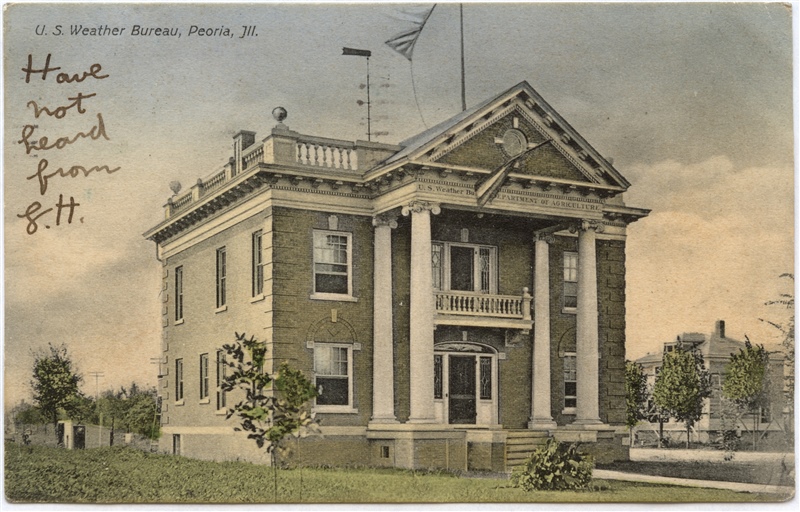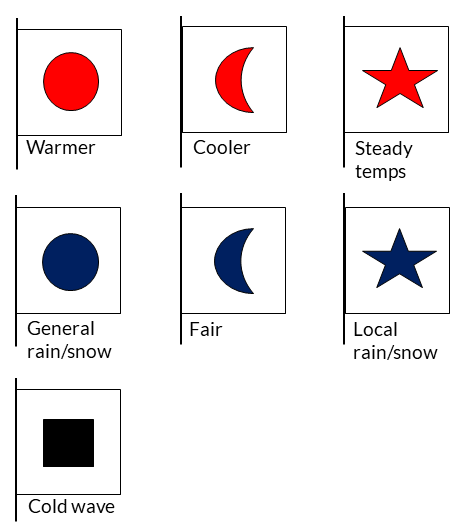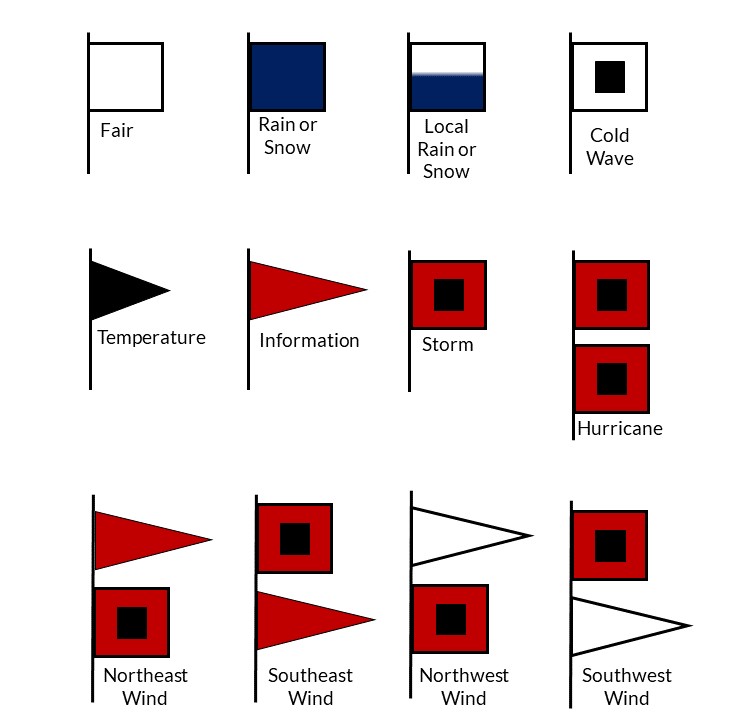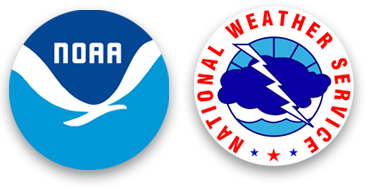A Brief History of Signal Flags - National Weather Service Heritage

A Brief History of Signal Flags
By Chris Geelhart (Chris.Geelhart@noaa.gov)Above: The Weather Bureau office in Peoria, Illinois, in the early 1900's displays its signal flags on the roof.
From the earliest days of the Army Signal Service, flags were used to signal messages. Gen. Albert Myer devised a visual communications system called aerial telegraphy (or "wig-wag"), which the Army adopted in 1860. When Myer was placed in charge of the Signal Service's new meteorological agency in 1870, it was only natural that signal flags would find a home there as well.
Reflecting on the historical reasoning behind the meteorological aspect of the Signal Service, maritime related signal flags were established in October 1871. The initial signal flag was red, with a black square inside (a red light was displayed at night instead), and was used at 20 ports on the Atlantic and Gulf Coasts, as well as the Great Lakes. The first official use of this flag occurred on October 26, 1871, in Oswego, New York.

Originally, the Signal Service public weather forecasts were distributed as "Farmers Bulletins," displayed in front of local post office buildings. This method continued until 1881, when it was replaced by the user of large white flags displayed over the post offices. The flags, being larger and more visual (for example, the "cold wave" flag measured 6 feet by 8 feet), were more useful. By 1886, the display flags were available in 290 locations, and requests came from private citizens for permission to display the flags, provided the Signal Service covered the cost of the telegraph. From there, the forecast was relayed downstream by telephone, telegraph and railway. Due to the popularity, W.B Hazen, the Chief Signal Officer at the time, recommended that $5000 be allocated in the 1886-87 fiscal year to expand the network. In the "Annual Report of the Chief Signal Officer of the Army to the Secretary of War," Hazen wrote: "There is no feature of the service which has proven more valuable, and the system should be extended to every town in the United States, and also to stock agricultural districts when practicable."
A representation of the signal flags used at the time are at the right. It should be noted the order of display did not have any significance. Railways that mounted the forecast on the side of rail cars used the inside symbols rather than the flags themselves.
Although the Weather Bureau continued the practice of using signal flags, the design of the flags changed over time. The circle, crescent and star were removed. A triangular flag was introduced to represent the temperature trend, and its placement in relation to the precipitation flag indicates whether the temperature would be warmer or colder (absence of the triangular flag meant a steady temperature). Precipitation was indicated by blue shading on the flag. Railways continued to mount the forecast on rail cars, and also used coded steam-whistle signals in locations where the flags could not be seen. Around 630 signal flag stations were in operation at the start of July 1891, when the Signal Service handed over its meteorological operation to the Weather Bureau.

The use of maritime flags expanded in the mid-1890s to include the implementation of wind and hurricane flags. By the middle of 1895, 173 wind signal stations were in operation, with 64 of these operated on a volunteer basis by local interests. A series of vertical lights was added in 1916 for nighttime use.
As time went by, forecast distribution grew to include mail delivery, newspapers, and (eventually) radio. The Weather Bureau recognized the decreased importance of the flags, and announced in July 1927 that the flags would be phased out once their existing stock of replacement flags had been exhausted. However, the signal flags persisted in some areas. The Rapid City (S.D.) Journal from September 15, 1923, reported that the local Weather Bureau continued to receive many inquiries on interpreting the flags. A branch of the Oshkosh (Wis.) Boy Scouts began displaying the flags in January 1933 to mark the anniversary of the Scouts. The La Crosse (Wis.) Tribune of January 16, 1942, reported the elimination of the flags as part of the government effort to censor weather reports that could potentially aid the enemy in the event of an invasion. However, they were pleased to report in the May 20, 1945 edition that the local flags were once again in place. The final blow was likely the use of television and newspapers to relay the forecast, and even in La Crosse, the flags were gone before 1960 as they had become largely symbolic.
As even more modern methods of forecast distribution became available, the signal flags slowly faded into disuse. However, their singular goal would remain a part of the Bureau for the decades that followed: serving, informing, preparing, and protecting people all over the country.
